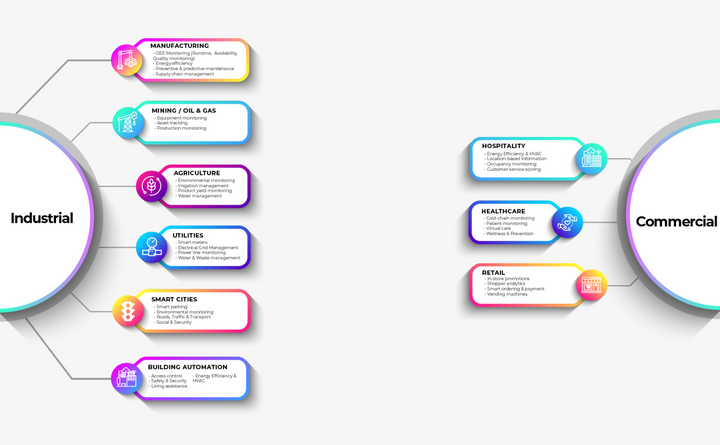How Industrial IoT Is Blurring The Lines Between IT & OT

When the Internet of Things was first mentioned in 1999, MIT Auto-ID labs co-founder Kevin Ashton described it as something that had the potential to disrupt the way we do things on a fundamental level. It wasn’t just about getting things to connect together—it was about humans getting to pull those things together, using the data collected on the internet to get “physical.”
In his article—published on June 22nd, 2009—he references the presentation held at Procter & Gamble ten years prior, describing what he means by “getting physical” with our data. Around that time, people seriously started considering IoT as the future of IT, but the core ideal has always been the same for Ashton—ideas and information are important, and yet things matter more.
That’s because we interact with things on a constant basis. Our phone is a thing, our car is a thing, our laptop, chargers, fridge, light switches, oven, air conditioning unit—you name it. There isn’t one single goal that we can accomplish if there isn’t at least one thing helping us dig through the complexity to surface on the other side. A “simple” idea that sparked a big conversation.
This is the perfect analogy for IT/OT convergence efforts that have taken the IoT world by storm in recent years. Information technology and operational technology are historically different from one another, and they never had much of a reason to fuse into one unified system, not until people started talking about IoT. Only then did business owners fully realize their potential.
Core Differences Between IT & OT
It’s important to explore these technologies at a high level before jumping into how IIoT (Industrial IoT) is planning to disrupt the world of industrial business. As previously stated, information- and operational technology have had nothing to do with each other for a while. They might have been developed around the same time, but they’ve only seen their first convergence in the early 2000’s.
So, what are the core difference between these two technologies?
Information Technology
You might already be familiar with the term “information technology.” It has to do with anything that includes the use of computers and data storage through a grid of networking devices that allow for creation, storage, and low-level processing of computer data.
The term “information technology” was first used in 1978, but its roots are deeply interconnected with computer science and computer engineering. The key point of information technology was (and still is) the processing of data by computers.
Today, information technology is all over the place. It’s not just about industrial technology, it’s about the infrastructure that you can find at your local station, or at the mall, or any other place that requires point A to point B connection via computers.
Operational Technology
On the other hand, operational technology has never been regarded as something that could make it out of the industrial sector. That’s because OT systems are so complex that they require constant checkups, making for great monitoring solutions in the industry.
With that said, the IT/OT convergence has tried to “ease” this complexity into more of a connected solution that could reduce costs while keeping value and productivity high. This has worked (to some degree), but it has also introduced extreme vulnerabilities that have had massive repercussions, including one of the biggest DDoS attacks in the history of IT.
No matter the vulnerabilities, operational technology (which traditionally involves mechanical tools) has seen great benefit from the steps that have been taken in order to make it more and more compatible with IT, so the convergence is extremely relevant.
These are the main characteristics to consider when we’re looking at the industrial internet of things. However, there is plenty more to learn about both IT and OT from this point of view, and you can find the most relevant information scattered throughout the links provided in this article.
Factors & Potential Business Benefits of IT/OT Integration
Considering the complexity that lies behind integrating these two technologies together, it’s clear that costs are often prohibitive. In 2014, Siemens clearly stated in their “2014 Utility IT/OT Convergence Survey” that cost was ranked as the top impediment for IT/OT convergence.
However, IT/OT integration has already shown clear signs of business benefits, such as:
- Being able to share data across the entire organization for multiple devices
- Streamlining the process of data collection by eliminating manual work
- Understanding how processes and monitoring tools behave in unison
- Acquiring actionable data that can be used for further growth
- Improving outage management and grid asset monitoring
… and a lot more.
Surely, IT/OT integration has had its perks in the industrial business environment, and while the cost might prove prohibitive, work is being done to take things even further. Standard industrial monitoring protocols such as PLCs, SCADA, DCS, or NCN systems are immensely valuable in manufacturing when connected to data that spans the entirety of the organization.
The only reasons why this hasn’t been fully completed yet is the preoccupation behind critical infrastructure vulnerabilities. Even if costs are high, manufacturers all over the world are eager to step into IIoT—they just don’t know how to do it without putting their most valuable assets at risk.
We at Ubidots are working hard to bring IoT implementations closer and closer to the industrial world. With our cloud development platform, manufacturing can become a smarter, simpler, and more effective process. Learn more about IoT for smart manufacturing here.

